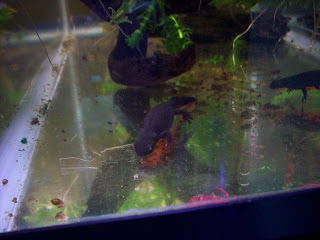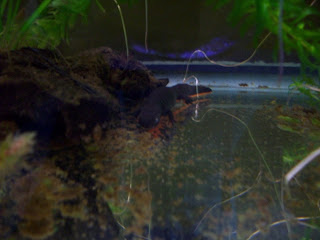jewett
Site Contributor
- Joined
- Sep 25, 2004
- Messages
- 827
- Reaction score
- 30
- Points
- 28
- Location
- West Jordan UT
- Country
- United States
- Display Name
- Heather Jewett
One of my Co's has recently developed a problem with its left eye. Heres the history:
Several weeks ago I moved both of my male Co's to their permanent 10 gallon tank after spending the last several months in quarantine. Within about a week of being in their new home I noticed both newts squinting their eyes or just keeping them closed almost all the time. This lasted for maybe about 2 weeks, and during this time the newt that I am still concerned about was shedding frequently and having difficulty shedding. Both animals continued to eat during this time, though activity decreased and they hid a lot. That has now stopped, and both animals are eating well, active (for a newt) and not squinting or keeping their eyes closed for long periods of time. But, the larger of the two males seems to have suffered trauma or disease to its left eye. There is a white film covering the entire eye, and at one spot (corner of the eye closest to the neck, "caudal" eye?) the white film is opaque. I am suspicious that the animal may be blind in that eye (or have severely limited vision), as it seems to turn its head to the right when it is interested in something. Can newts develop cataracts? Or perhaps when it was having difficulty shedding layers of unshed skin remained on the eye and that is what I am now seeing? I do not think the animal is in pain because it doesn't squint anymore and it is eating well, ate just this morning in fact. And there is no swelling around the eye that I can see so I don't think it could be a glaucoma or anything.
This is the set up:
The permanent tank has floating elodea/anacharis, some java fern, and wood that I collected from a stream and autoclaved before putting in the tank. Temps are 65F, and my water chemistry is all within normal parameters. No substrate, just a bare bottom tank. I keep a fluorescent light above the tank for the plants.
Here are some very poor pictures of the afflicted newt that I took this morning while they were eating their bloodworms (sorry they are so bad, I am no photographer!):


Anyone have any ideas? I am not too concerned as I think the newt still has good quality of life, but I am very curious. I also would like to be able to get rid of the film if that is possible.
Several weeks ago I moved both of my male Co's to their permanent 10 gallon tank after spending the last several months in quarantine. Within about a week of being in their new home I noticed both newts squinting their eyes or just keeping them closed almost all the time. This lasted for maybe about 2 weeks, and during this time the newt that I am still concerned about was shedding frequently and having difficulty shedding. Both animals continued to eat during this time, though activity decreased and they hid a lot. That has now stopped, and both animals are eating well, active (for a newt) and not squinting or keeping their eyes closed for long periods of time. But, the larger of the two males seems to have suffered trauma or disease to its left eye. There is a white film covering the entire eye, and at one spot (corner of the eye closest to the neck, "caudal" eye?) the white film is opaque. I am suspicious that the animal may be blind in that eye (or have severely limited vision), as it seems to turn its head to the right when it is interested in something. Can newts develop cataracts? Or perhaps when it was having difficulty shedding layers of unshed skin remained on the eye and that is what I am now seeing? I do not think the animal is in pain because it doesn't squint anymore and it is eating well, ate just this morning in fact. And there is no swelling around the eye that I can see so I don't think it could be a glaucoma or anything.
This is the set up:
The permanent tank has floating elodea/anacharis, some java fern, and wood that I collected from a stream and autoclaved before putting in the tank. Temps are 65F, and my water chemistry is all within normal parameters. No substrate, just a bare bottom tank. I keep a fluorescent light above the tank for the plants.
Here are some very poor pictures of the afflicted newt that I took this morning while they were eating their bloodworms (sorry they are so bad, I am no photographer!):
Anyone have any ideas? I am not too concerned as I think the newt still has good quality of life, but I am very curious. I also would like to be able to get rid of the film if that is possible.
Last edited:
